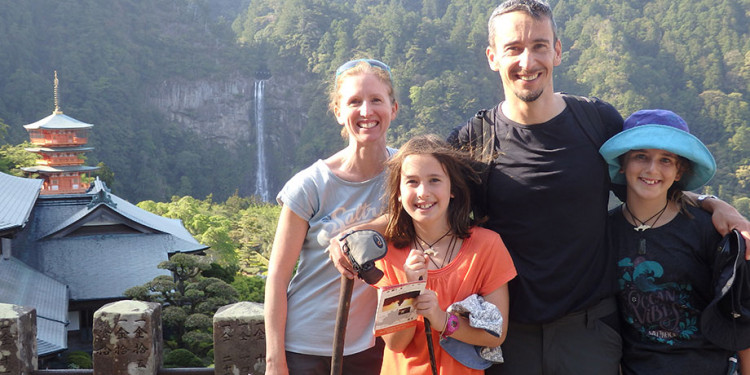
Dominick Stephens with his family at the end of a 100km walk in Japan
The allure of traveling the world on a gap year is usually one that seduces twenty-somethings early in their careers - people who usually lack the pressures of mortgage payments and childcare.
But an ‘adult gap year’ for professionals, who have a solid decade or more behind them in their career, is very do-able if planned well.
Westpac NZ’s Chief Economist Dominick Stephens took a year off recently.
“I’ve always thought I’d rather have a year off young, than two more in retirement, so I’ve done the OE a few times as a youngster and took a year off at 40 too,” he said.
Director of Westpac-Massey Fin-Ed Centre, Dr Pushpa Wood, recommends looking at what sector you are working in and the trends of that sector.
“Will it be easy to leave your job and come back in a year? Or do you plan to go back to the same job with the same employer if they support your time off?
“You must have a planned approach for contingency,” Dr Wood said.
Stephens, who is now 43, took a year off to look after his two children who were nine and 11 at the time, so that his wife could study full time.
After nine months of being a stay-at-home dad, Stephens and his family then spent the last three months of that year traveling the world, journeying through Japan, Borneo, Sri Lanka and Italy.
“I always live to a strict budget so that didn’t change, and I had saved enough for that year off,” Stephens said.
“The key is that it was a sabbatical from work, and I had planned for that and knew I was coming back to my same role.
“If you’re in-between jobs during the gap year, then it dominates your time worrying about finding your next job at the end of it. I didn’t have that stress and that is key,” he said.
Dr Wood advises that one should look at the reasons why they want a career break to determine how much time they need to take off to fulfil their intention.
“Ideally you might want one year but you only have enough income for three months.
“Then you need to see if you are contributing to a retirement fund, what will happen to your payments without incurring penalties?
“Will you be able to fund your rent or mortgage during the time off and what other funds will be available?” she said.
Stephens spent a long time planning his gap year with Westpac’s support before it was realised.
“Maternity leave was the model I based my break around,” he said.
“The model works for maternity leave where we have someone on secondment covering the role.
“It puts new blood into the team while retaining our long-term talent, so it worked well. I had managed those maternity leave handovers well in my own team, so management trusted that my own sabbatical would work.
“And people are used to flexible work practices these days. My 2IC took over my role for a year and my job was secured.
“It also gave my staff a chance to grow and mature as they took on more responsibility,” he said.
The year off not only gave Stephens more time with his family, but he learnt Japanese, delved into his hobbies such as chess and sailing and became an active social member within his community.
“The first thing I noticed when I came back to work is that everyone said, ‘oh wow has it been a year already?’
“For my colleagues it was almost like I never went away, but to me it felt like five years.
“I slotted back in easily, had more enthusiasm and found new ways to do the job and learnt to delegate more productively,” he said.
The lasting impact of the break has seen Stephens’ personal relationship with his family strengthen as well as his professional aptitude.
Stephens has worked for Westpac since 2006 and has been Chief Economist since 2011.
